Abstract
The term occult pneumothorax (OP) describes a pneumothorax that is not suspected on the basis of clinical examination or plain radiography but is ultimately detected with thoracoabdominal computed tomography (CT). This situation is increasingly common in trauma care with the increased use of CT. The rate is approximately 5% in injured people presenting to hospital, with CT revealing at least twice as many pneumothoraces as suspected on plain radiography. Whereas pneumothorax is a common and treatable cause of mortality and morbidity, there is substantial disagreement regarding the appropriate treatment of OP. The greatest controversy is in patients in the critical care unit who require positive-pressure ventilation. There is little current evidence to direct the proper management of ventilated trauma patients with OP, and no studies have focussed specifically on these patients. Future randomized trials will need to consider the potential effects of OP on pulmonary mechanics and potential influences on the known risks of ventilator-induced lung injury associated with mechanical ventilation.
Abstract
Le pneumothorax occulte (PO) se dit d'un pneumothorax que l'examen clinique et la radiographie ordinaire n'ont pas permis de soupçonner mais qui est finalement détecté par tomodensitométrie thoraco-abdominale. Cette situation est de plus en plus courante en traumatologie, étant donné l'utilisation accrue de la tomodensitométrie. Le taux s'établit à environ 5 % chez les traumatisés qui se présentent à l'hôpital, la tomodensitométrie révélant au moins deux fois plus de pneumothorax que la radiographie ordinaire. Le pneumothorax est une cause courante et traitable de mortalité et de morbidité, mais on ne s'entend pas du tout quant au traitement approprié de cette affection. La prise en charge des patients traités aux soins intensifs et ayant besoin de ventilation à pression positive soulève la plus grande controverse. À l'heure actuelle, il n'existe guère de données probantes pour orienter le traitement indiqué des patients traumatisés et ventilés présentant un PO, et aucune étude ne porte particulièrement sur ces patients. Les études cliniques randomisées à venir devront tenir compte des effets éventuels du PO sur le fonctionnement du poumon ainsi que des influences possibles sur les risques connus de lésions pulmonaires provoquées par un ventilateur et subordonnés à la ventilation artificielle.
Thoracic injury accounts for 25% of all trauma-related deaths.1 The second most common blunt chest injury, pneumothoraces are a notable cause of preventable death, but relatively simple interventions may be lifesaving.2,3,4 Pneumothoraces may be dynamic, with delayed, but life-threatening manifestations arising at any time during the patient's hospitalization. They may also cause a disproportionate degree of cardiopulmonary instability compared with chest injuries of similar anatomic severity.5,6 They are of particular concern in trauma patients requiring positive-pressure mechanical ventilation because they may progress rapidly to a tension pneumothorax.7,8,9,10 In such cases, the intrapleural pressure rises, the mediastinum shifts and the diaphragm is depressed. These events may be associated with decreased lung capacity, anatomic shunting, hypoventilation and ventilation–perfusion mismatch of collapsed underventilated lungs.11 Cardiac output may be further embarrassed because of obstructive shock.7
Occult pneumothorax (OP) is becoming common owing to the increasing use of computed tomography (CT) as the investigation of choice for blunt thoracoabdominal trauma. OP was originally defined as a pneumothorax identified by CT of the abdomen that was not seen on conventional supine anterosuperior chest radiography (CXR).12,13,14,15 OP may be present when conventional chest radiography is clearly abnormal (Fig. 1) or relatively normal (Fig. 2). This is not surprising as CXR is the least sensitive of all the plain radiographic techniques for demonstrating a pneumothorax.5,8,16,17 Cadaver studies require up 400 mL of air in the pleural space with the patient in a supine position to confidently detect pneumothorax.18 Unfortunately, competing concerns regarding spinal injuries, hemodynamic compromise and concomitant clinical interventions make this the only practical view that can be obtained in many cases. Although careful review of the plain chest radiograph may reveal evidence of basilar hyperlucency, a deep sulcus sign or a double diaphragm; these pneumothoraces are often easily seen by studying lung windows on a thoracoabdominal CT scan. With the increasingly frequent finding of these unsuspected pneumothoraces, treating physicians must answer a series of questions. How common are they? How important are they? Do they require formal decompression? The controversy surrounding these questions is no more acute, nor important, than in the critical care unit.
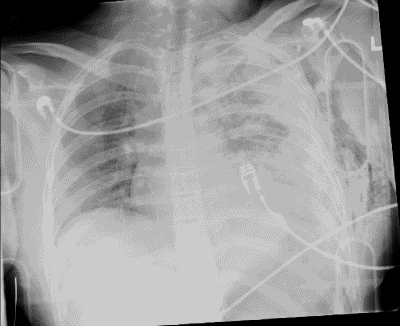
FIG. 1. Left: anterosuperior supine chest radiograph of blunt trauma victim revealing left posterolateral rib fractures and parenchymal opacity due to pleural fluid and pulmonary contusion. There is no obvious pneumothorax. Right: computed tomography scan reveals a large occult left-sided pneumothorax.
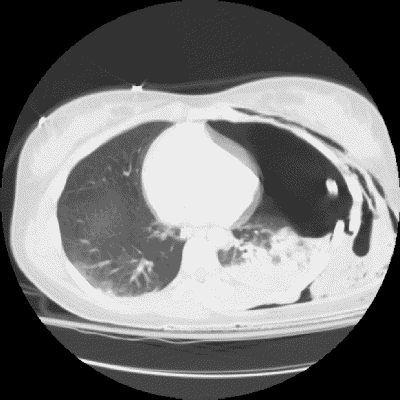
Figure 1. Continued.
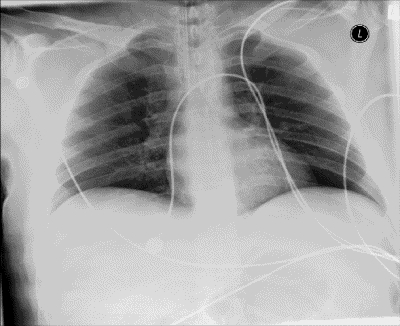
FIG. 2. Left: anterosuperior supine chest radiograph of blunt trauma victim. There is no obvious pneumothorax. Right: computed tomography scan reveals a large occult left-sided pneumothorax.
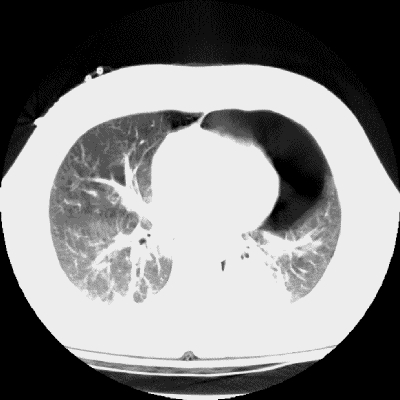
Figure 2. Continued.
Epidemiology
Overall, OPs are quite common and will be seen regularly in the daily practice of caring for the trauma patient. The specific rate depends on the population in question and whether it has been preselected in some way regarding injury severity or previous diagnostic tests (Table 1 5,8,12,13,15,18,19,20,21,22,23,24,25,26,27). In 1983, Wall and colleagues12 reported that 10 (28%) of 35 pneumothoraces detected by abdominal CT were occult, representing 2% of their 500 patients. Subsequently, a number of authors have reported a remarkably consistent incidence of OPs ranging from 5.2% to 8.0% for injured patients presenting to hospital.8,15,18,19,21,22,25 In 1989 in a series of 174 trauma patients, Rhea and colleagues18 found 8 OPs in 15 patients for a 4.6% incidence. Subsequently, Garramone and associates,19 Wolfman and colleagues,21 Brasel and associates,15 Hill and associates,22 and Neff and colleagues,8 reported rates of 5.7%, 5.4%, 5.2%, 8.0% and 5.4% in groups of 457, 664, 1669, 3121 and 2312 patients, respectively. A pediatric survey also reported a 2% incidence among 538 children.26 In these studies, the proportion of pneumothoraces that were occult compared with those that were actually seen on CXR have ranged from 29% to 72%, the majority having a rate greater than 50% (Table 1).
Table 1

Although the term occult pneumothorax was first defined as a “pneumothorax not seen on CXR but detected on the abdominal CT,”8,14,15,19 chest CT is an intuitive and obvious method of diagnosing additional OPs.25,28 In critically ill people who were effectively triaged by their injury severity to undergo a thoracic CT, the proportion of OPs appears to be even higher. In a study of 25 consecutive patients with severe head trauma, a limited chest CT found 21 pneumothoraces, of which 11 (52%) were occult.13 Four studies have subsequently utilized thoracic CT for high-risk trauma patients, admitted to a critical care unit23,24 or with chest radiographs that revealed a suspicion but not a diagnosis of pneumothorax.5,27 In intubated polytrauma patients evaluated with thoracic CT, 25 pneumothoraces were detected in 39 patients, 72% of which were not detected by CXR.23 In a Spanish critical care unit, 60% of all the pneumothoraces detected were occult.24 This is consistent with the 71% rate reported from a German unit.5 Rowan and colleagues,27 in Vancouver, examined 27 traumatized patients with thoracic CT and found 11 pneumothoraces of which 7 (64%) were occult. This group examined these same patients with a novel sonographic technique, which had a significantly higher sensitivity for detecting these OPs than CXR.27,29
Thus, the frequency with which a clinician will encounter this entity will depend on how seriously injured the patient is and where the patient is assessed (i.e., in the emergency room or at a later stage of hospitalization). Usually, OPs seem to be found unexpectedly on CT scans in about 5% of the general trauma population. CT typically reveals at least twice as many pneumothoraces as are suspected from the anteroposterior CXR. In the foreseeable future the number of OPs detected in traumatized patients will only increase. Thoracic CT is increasingly being used to investigate the mediastinum, thoracic spine and diaphragm, as well as to detect pulmonary emboli.5,30,31 Thoracic sonography, a simple test with greater sensitivity in detecting OPs, also may play an increasing role.27,32
Significance of occult pneumothorax and its management
Delayed or missed treatment of post-traumatic pneumothoraces has been reported to be a leading cause of preventable morbidity,4,6 so the traditional management of nearly all of them detected clinically or on CXR has been to place a chest tube. 7 Guidelines regarding spontaneous pneumothoraces are more liberal, and typically may be treated with observation if a patient is otherwise asymptomatic and the pneumothorax is “small” (< 3 cm from the lung apex to the ipsilateral thoracic cupola33).34 With limited scientific evidence, the significance of the OP has been variously and widely interpreted by different groups of physicians. It is probable that these OPs existed and remained untreated previously but are only now apparent due to our increased use of 3-dimensional imaging. Clinical opinion supports close observation, as long as the patient is asymptomatic and is not ventilated.15,20,22,26,35 Chest tubes should be placed if the OP increases in size or if the patient becomes symptomatic. However, chest tube placement is associated with morbidity: pain, vascular injury, improper positioning of the tube, inadvertent tube removal, post-removal complications, longer hospital stays, empyema and pneumonia have been reported in up to 21% of cases.14,15,35,36
Classification of occult pneumothoraces
It seems intuitive for clinicians to consider the size of a pneumothorax, since the volume of intrapleural air may be related to both the size of the air leak and the time required for spontaneous resolution. Wolfman and colleagues21 have classified OPs as “miniscule,” “anterior” or “anterolateral” on the basis of CT findings. Miniscule pneumothoraces were no more than 1 cm thick and seen on 4 or fewer contiguous 10-mm images. Anterior pneumothoraces were thicker than 1 cm but did not extend posterior to the mid- thoracic coronal line whereas anterolateral pneumothoraces did; both types comprised 4 or more 10-cm slices.21 This scale has also been used by Holmes and associates.26 Others have directly estimated the size of OPs on CT by describing the maximal width and the number of 10-mm sections in which the pneumothorax appeared.15,19
Occult pneumothorax and positive-pressure ventilation
Although the intubated and ventilated patient is at the greatest risk, proper management of an OP is extremely controversial and based on little scientific evidence. Many of these patients are already compromised owing to acquired or pre-existing pulmonary conditions, and clinical respiratory distress may be masked by concomitant respiratory support and sedation. The risk of progression of a known pneumothorax to a tension pneumothorax has generally been considered a serious concern, warranting prophylactic chest tube placement for the patient who is subjected to positive-pressure ventilation.5,11,12,13,18,20,25 Kollef37 also reported that in ventilated patients with pneumothoraces a tension pneumothorax was statistically more likely to develop when the diagnosis was missed or delayed. The guidelines of the Advanced Trauma Life Support of the Committee on Trauma of the American College of Surgeons state that general anesthesia or positive-pressure ventilation should never be administered without a chest tube being placed in any patient who has sustained a traumatic pneumothorax or is at risk for an unexpected pneumothorax.7
Other sources have not supported these admonitions concerning OPs. The critical care unit cohort also represents a patient group in which complications of tube thoracostomy have been found to be the highest. Etoch and associates36 reported that intensive care admission and mechanical ventilation were independently associated with increased chest tube complications. This group also represents a population who will be closely observed. Garramone and associates19 retrospectively noted that size of the OP and number of rib fractures affected outcome by influencing when clinicians placed chest tubes (Table 2 14,15,19,21,22,35).
Table 2
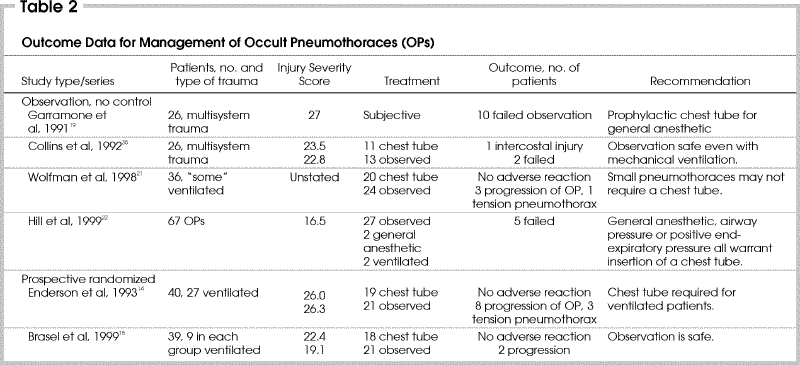
If an OP was less than 5 mm by 80 mm, and associated with 2 or fewer rib fractures, they believed it could be managed conservatively, irrespective of the need for ventilation. Ten (59%) of 17 patients managed without chest tubes were intubated and ventilated with positive pressures. None of these patients required emergency thoracostomy secondary to respiratory failure or hemodynamic compromise; however, 3 of these 10 ultimately required a chest tube because of progression of their pneumothorax.19 Collins and associates35 retrospectively identified 26 patients with OPs and compared the characteristics and outcomes of 13 who were observed with repeated CXR and 11 who underwent early chest tube placement. Ten of the 26 were ventilated, and 6 of the 10 were managed without a chest tube. Although 1 of these (17%) failed observation (pneumothorax progression), they concluded there was no support for the contention that an OP warranted a prophylactic chest tube prior to positive-pressure ventilation.35 Wolfman and colleagues21 observed OPs in 36 patients. Thirteen of 16 miniscule OPs and 11 of 20 moderate (anterior) pneumothoraces were managed successfully with conservative treatment, for an 11% failure rate of observation, including 1 tension pneumothorax. The 8 remaining anterolateral pneumothoraces were all treated with tube thoracostomy, whether intubated or not. Most of the patients failing observation secondary to progression of the pneumothorax had been intubated and ventilated. These authors concluded from their results that only small and moderate OPs without mechanical ventilation could be safely observed as they had not randomized the anterolateral OPs.21 Hill and associates22 noted that a total of 165 operations were performed on 127 patients with OP. Fifty-one (31%) of the group were on a mechanical ventilator, the average duration of ventilation being 12.6 days. Twenty-seven (16%) patients with OP were observed without a chest tube at some time during mechanical ventilation, although the authors did not specifically delineate the outcome of this. They found that in 5 (29%) of these 27 cases conservative treatmen failed, and the patients required a chest tube for OP progression. There were no tension pneumothoraces, however. They also observed that only the size of the pneumothorax was statistically associated with the need for a chest tube. They felt that only if a general surgeon was not involved in an operative case or if long-term high-pressure ventilation was required was a prophylactic chest tube indicated. Guerrero-Lopez and associates24 stated that OPs did not always require treatment despite mechanical ventilation if they were “small and without complications.”
The best, although very limited, evidence guiding management of OPs in ventilated patients originates from 2 small prospective randomized studies. In 1993, Enderson and associates14 randomized 40 patients with OPs to tube thoracostomy (19) or observation (21), without regard for mechanical ventilation. Fifteen “observed” patients were ventilated as were 12 with early placement of chest tubes. These authors reported that 8 (53%) of the 15 had progression of their OP with positive-pressure ventilation, 3 suffering tension pneumothoraces. None of the patients with tube thoracostomy suffered any major complications while on positive-pressure ventilation, or because of chest tube placement. As a result of this morbidity, the authors strongly recommended that all patients with OP who require mechanical ventilation undergo tube thoracostomy. They also commented that the size of the initial OP was not predictive of progression or of formation of a tension pneumothorax.
Conversely, in 1999, Brasel and associates15 reported on a 24-month, prospective randomized trial in 39 blunt trauma patients with 44 OPs. Nine patients in each group were ventilated, and there was no statistical difference in the sizes of the OPs. There were no differences in complications, and no patients in either group required emergent tube thoracostomy for respiratory compromise. Two of the 9 patients on positive-pressure ventilation did receive a chest tube secondary to progression of the OP. Given the small numbers, this finding did not reach statistical significance, and there was no association between the size of the OP and failure of conservative treatment. Brasel's group did conclude though that OPs could be safely observed in ventilated patients. It should be noted that one possible explanation for the discrepancy between studies was that the ventilatory management of patients may have varied, as most of Brasel's patients were in the intensive care unit and most of Enderson's were in the operative suite. Ventilation strategies in general have also changed substantially over the past decade. Decreased airway pressures and tidal volumes are now routine in the critically ill. Contemporary ventilatory management stresses careful attention to controlling peak and mean airway pressures, limiting pressures below those considered routine previously.38,39,40
Ventilator-induced lung injury
Any discussion of the influence of OPs in critical care needs to consider the effects of ventilator-induced lung injury. Although reported studies do not show obvious differences in the occurrence of overt cardiopulmonary disasters such as tension pneumothoraces or deaths, the influence of pneumothoraces on the pulmonary mechanics of susceptible patients remains unknown and deserves further study. In this regard, the effects of observing OPs on pulmonary mechanics is poorly described. In the ventilated patient, rises in peak and plateau pressures signal the possibility of a pneumothorax. It is also well known that when the lungs are exposed to high ventilatory volumes, tissue disruption and lung injury may result from combinations of barotrauma, volutrauma and an increased production of inflammatory mediators, or biotrauma.41,42,43 When ventilatory pressures are not controlled, the incidence of spontaneous pneumothoraces may reach as high as 60% of those at high risk.44 Obvious forms of “classic” barotrauma, causing respiratory collapse or resulting in persistent bronchopleural fistulas are unlikely until peak airway pressures are greater than 50 cm H2O,45 however. Experimental evidence suggests that inflammatory mediators may be produced at ventilatory pressures well below the perceived threshold for obvious barotrauma. Investigators have shown significant differences in inflammatory mediators by using a lung-protective strategy compared to conventional ventilatory management, even though the mean end- inspiratory plateau pressure was still only 31 cm H2O in the control populations.43,46 Such data have led to a general acceptance of “lung- protective ventilatory strategies” for patients at risk of ventilator-induced lung injury.
The inflection points of the inspiratory pressure–volume curves have been proposed as a means of adjusting ventilator settings to minimize ventilator-induced lung injury.47,48 The positions of these inflection points, however, are dynamic and sensitive to physiologic conditions such as edema and chest wall compliance.47,49 We do not know whether the altered pulmonary compliance from an OP would exacerbate ventilator-induced lung injury. The beneficial results of pleural drainage of fluid in acute respiratory failure suggest that mechanics should be improved.50 On the other hand, the need for increased ventilatory pressures due to increased pleural pressure may not directly affect the transalveolar pressure, the true effector of lung stretch.40,51 The increased concentration of inspired oxygen (FIO2) that may be administered through the ventilator might facilitate spontaneous resolution of OPs that are observed with a chest tube. It has been estimated that the volume of a simple pneumothorax decreases by 1.25% each day due to gas absorption.52 Administering 100% oxygen may increase this rate of absorption 4- to 6-fold53,54 but conflicts with the principles of reducing oxygen concentrations consistent with lung-protective ventilatory strategies.55 Current guidelines for avoiding ventilator-induced lung injury stress maintaining the FIO2 at the lowest level commensurate with adequate tissue oxygenation and certainly below 60%.41,55 Without further study these issues are speculative.
Conclusions
With respect to OP in mechanically ventilated trauma patients, there are few studies to help answer critical questions. A number of retrospective studies do comment on the incidence of this diagnosis and provide opinions for proper management, but the evidence is essentially based on 2 small prospective randomized trials in the literature, involving only 36 ventilated trauma patients who were actually randomized to the treatment of their OPs. Furthermore, significant failure rates (up to 38%) are associated with the observation of patients subjected to positive-pressure ventilation. Epidemiologic studies should be carried out to determine the incidence of OPs in the typical populations and to elucidate the natural history with and without positive-pressure ventilation. Appropriately powered, and thus presumably multicentred randomized controlled trials, between treatment and observation are needed to guide clinicians.
Competing interests: None declared.
Correspondence to: Dr. Andrew W. Kirkpatrick, Foothills Medical Centre, Rm. EG23, 1403–29th St. NW, Calgary AB T2N 2T9; fax 403 944-1277; Andrew.Kirkpatrick@CalgaryHealthRegion.ca
Accepted for publication July 22, 2003.
References
- 1.Shorr RM, Crittenden M, Indeck M, Huartunian SL, Rodriguez A. Blunt thoracic trauma: analysis of 515 patients. Ann Surg 1987;206:200-5. [DOI] [PMC free article] [PubMed]
- 2.Blaisdale WF. Pneumothorax and hemothorax. In: Blaisdale WF, Trunkey DD, editors. Trauma management. 3rd ed. New York: Thieme; 1986. p. 150-65.
- 3.Richardson JD, Miller FB. Injury to the lung and pleura. In: Felician DV, Moore EE, Mattox KL, editors. Trauma. 3rd ed. Stamford (CT): Appleton & Lange; 1996. p. 387-407.
- 4.Stocchetti N, Pagliarini G, Gennari M, Baldi G, Banchini E, Campari M. Trauma care in Italy: evidence of in-hospital preventable deaths. J Trauma 1994;36:401-5. [PubMed]
- 5.Trupka A, Waydhas C, Hallfeldt KK, Nast-Kolb D, Pfeifer KJ, Schweiberer L. Value of thoracic computed tomography in the first assessment of severely injured patients with blunt chest trauma: results of a prospective study. J Trauma 1997;43:405-12. [DOI] [PubMed]
- 6.Di Bartolomeo S, Sanson G, Nardi G, Scian F, Michelutto V, Lattuada L. A population-based study on pneumothorax in severely traumatized patients. J Trauma 2001;51:677-82. [DOI] [PubMed]
- 7.American College of Surgeons Committee on Trauma. Advanced trauma life support course for doctors. Instructors course manual. Chicago: American College of Surgeons; 1997.
- 8.Neff MA, Monk JS, Peters K, Nikhilesh A. Detection of occult pneumothoraces on abdominal computed tomographic scans in trauma patients. J Trauma 2000;49:281-5. [DOI] [PubMed]
- 9.Plewa MC, Ledrick D, Sferra JJ. Delayed tension pneumothorax complicating central venous catheterization and positive pressure ventilation. Am J Emerg Med 1995;13:532-5. [DOI] [PubMed]
- 10.Chen YC, Lin SF, Liu CJ, Jiang DD, Yang PC, Chang SC. Risk factors for ICU mortality in critically ill patients. J Formos Med Assoc 2001;100:656-61. [PubMed]
- 11.Karnik AM, Khan FA. Pneumothorax and barotrauma. In: Parillo JE, Dellinger RP, editors. Critical care medicine: principles of diagnosis and management in the adult. 2nd ed. St. Louis: Mosby; 2001. p. 930-48.
- 12.Wall SD, Federle MP, Jeffrey RB, Brett CM. CT diagnosis of unsuspected pneumothorax after blunt abdominal trauma. Am J Radiol 1983;141:919-21. [DOI] [PubMed]
- 13.Tocino IM, Miller MH, Frederick PR, Bahr AL, Thomas F. CT detection of occult pneumothoraces in head trauma. AJR Am J Roentgenol 1984;143:987-90. [DOI] [PubMed]
- 14.Enderson BL, Abdalla R, Frame SB, Casey MT, Gould MT, Gould H, et al. Tube thoracostomy for occult pneumothorax: a prospective randomized study of its use. J Trauma 1993;35:726-30. [PubMed]
- 15.Brasel KJ, Stafford RE, Weigelt JA, Tenquist JE, Borgstrom DC. Treatment of occult pneumothoraces from blunt trauma. J Trauma 1999;46:987-91. [DOI] [PubMed]
- 16.Toombs BD, Sandler CM, Lester RG. Computed tomography of chest trauma. Radiology 1981;140:733-8. [DOI] [PubMed]
- 17.Winter R, Smethurst D. Percussion — a new way to diagnose a pneumothorax. Br J Anaesth 1999;83:960-1. [DOI] [PubMed]
- 18.Rhea JT, Novelline RA, Lawrason J, Sackoff R, Oser A. The frequency and significance of thoracic injuries detected on abdominal CT scans of multiple trauma patients. J Trauma 1989;29:502-5. [DOI] [PubMed]
- 19.Garramone RR, Jacob LM, Sahdev P. An objective method to measure and manage occult pneumothoraces. Surg Gynecol Obstet 1991;173:257-61. [PubMed]
- 20.Bridges KG, Welch G, Silver M, Schino MA, Esposito B. CT diagnosis of occult pneumothoraces in multiple trauma patients. J Emerg Med 1993;11:179-86. [DOI] [PubMed]
- 21.Wolfman NT, Myers MS, Glauser SJ, Meredith JW, Chen MY. Validity of CT classification on management of occult pneumothorax: a prospective study. AJR Am J Roentgenol 1998;171:1317-23. [DOI] [PubMed]
- 22.Hill SL, Edmisten T, Holtzman G, Wright A. The occult pneumothorax: an increasing entity in trauma. Am Surg 1999;65:254-8. [PubMed]
- 23.Voggenreiter G, Aufmkolk M, Majetschak M, Assenmacher S, Waydhas C, Obertacke U, et al. Efficacy of chest computed tomography in critically ill patients with multiple trauma. Crit Care Med 2000;28:1033-9. [DOI] [PubMed]
- 24.Guerrero-Lopez F, Vasquez-Mata G, Alcazar-Romero P, Fernandez-Mondejar E, Aguayo-Hoyos E, Linde-Valverde CM. Evaluation of the utility of computed tomography in the initial assessment of the critical care patient with chest trauma. Crit Care Med 2000;28:1370-5. [DOI] [PubMed]
- 25.Omert L, Yeaney WW, Protech J. Efficacy of thoracic computerized tomography in blunt chest trauma. Am Surg 2001;67:660-7. [PubMed]
- 26.Holmes JF, Brant WE, Bogren HG, London KL, Kupperman N. Prevalence and importance of pneumothoraces visualized on abdominal computed tomographic scan in children with blunt trauma. J Trauma 2001;50:516-20. [DOI] [PubMed]
- 27.Rowan KR, Kirkpatrick AW, Liu D, Forkheim D, Mayo JR, Nicolaou S. Traumatic pneumothorax detection with thoracic US: correlation with chest radiography and CT — initial experience. Radiology 2002;225:210-4. [DOI] [PubMed]
- 28.McGonigal MD, Schwab CW, Kauder DR, Miller WT, Grumbach K. Supplemental emergent chest computed tomography in the management of blunt torso trauma. J Trauma 1990;30:1431-5. [DOI] [PubMed]
- 29.Kirkpatrick AW, Ng A, Dulchavsky SA, Lyburn I, Harris A, Torregianni W, et al. Sonographic diagnosis of a pneumothorax inapparent on plain chest radiography: confirmation by computed tomography. J Trauma 2001;50:750-2. [DOI] [PubMed]
- 30.Parker MS, Matheson TL, Rao AV, Sherbourne CD, Jordan KG, Landay MJ, et al. Making the transition: the role of helical CT in the evaluation of potentially acute thoracic injuries. AJR Am J Roentgenol 2001;176:1267-72. [DOI] [PubMed]
- 31.Enden T, Klow NE. CT pulmonary angiography and suspected pulmonary embolism. Acta Radiol 2003;44:310-5. [DOI] [PubMed]
- 32.Cunningham J, Kirkpatrick AW, Nicolaou S, Liu D, Hamilton DR, Lawless B, et al. Enhanced recognition of “lung sliding” with power color Doppler imaging in the diagnosis of pneumothorax. J Trauma 2002;52:769-71. [DOI] [PubMed]
- 33.Baumann MH, Strange C, Heffner JE, Light R, Kirby TJ, Klein J, et al. Management of spontaneous pneumothorax. Chest 2002;119:590-602. [DOI] [PubMed]
- 34.Scott SM. The pleura and empyema. In: Sabiston DC, editor. Textbook of surgery. 14th ed. Philadelphia: WB Saunders; 1991. p. 1718-26.
- 35.Collins JC, Levine G, Waxman K. Occult traumatic pneumothorax: immediate tube thoracostomy versus expectant management. Am Surg 1992;58:743-6. [PubMed]
- 36.Etoch SW, Bar-Natan MF, Miller FB, Richardson JD. Tube thoracostomy: factors related to complications. Arch Surg 1995;130:521-6. [DOI] [PubMed]
- 37.Kollef MH. Risk factors for the misdiagnosis of pneumothorax in the intensive care unit. Crit Care Med 1991;19:906-10. [DOI] [PubMed]
- 38.Ventilation with lower tidal volumes as compared with traditional tidal volumes for acute lung injury and the acute respiratory distress syndrome. The Acute Respiratory Distress Syndrome Network. N Engl J Med 2000;342:1301-8. [DOI] [PubMed]
- 39.Pinhu L, Whitehead T, Evans T, Griffiths M. Ventilator-associated lung injury. Lancet 2003;361:332-40. [DOI] [PubMed]
- 40.Kirkpatrick AW, Meade MO, Stewart TE. Lung protective ventilatory strategies in ARDS. In: Vincent JL, editor. 1996: yearbook of intensive care and emergency medicine. Berlin: Springer Verlag; 1996. p. 398-410.
- 41.Kirkpatrick AW, Meade MO, Mustard RA, Stewart TE. Strategies of invasive ventilatory support in ARDS. Shock 1996;6(Suppl 1):S17-22. [PubMed]
- 42.Gattinoni L, Chiumello D, Russo R. Reduced tidal volumes and lung protective ventilatory strategies: Where do we go from here? Curr Opin Crit Care 2002;8:45-50. [DOI] [PubMed]
- 43.Ranieri VM, Giunta F, Suter PM, Slutsky AS. Mechanical ventilation as a mediator of multisystem organ failure in acute respiratory distress syndrome [letter]. JAMA 2000;284:43-4. [DOI] [PubMed]
- 44.Marcy TW. Barotrauma: detection, recognition, and management. Chest 1993;104:360-5. [DOI] [PubMed]
- 45.Petersen GW, Baier H. Incidence of pulmonary barotraumas in a medical ICU. Crit Care Med 1983;11:67-9. [DOI] [PubMed]
- 46.Ranieri VM, Suter PM, Tortorella C, Tullio RD, Dayer JM, Brienza A, et al. Effect of mechanical ventilation on inflammatory mediators in patients with acute respiratory distress syndrome. JAMA 1999;282: 54-61. [DOI] [PubMed]
- 47.Ricard JD, Dreyfuss D, Saumon G. Ventilator-induced lung injury. Curr Opin Crit Care 2002;8:12-20. [DOI] [PubMed]
- 48.Amato MB, Barbas CS, Medeiros DM, Magaldi RB, Schettino GP, Lorenzi-Filho G, et al. Effect of a protective-ventilation strategy on mortality in the acute respiratory distress syndrome. N Engl J Med 1998;338:347-54. [DOI] [PubMed]
- 49.International consensus conference in intensive care medicine: ventilator-associated lung injury in ARDS [review]. Am J Respir Crit Care 1999;160:2118-24. [DOI] [PubMed]
- 50.Talmor M, Hydro L, Gershenwald JG, Barie PS. Beneficial effects of chest tube drainage of pleural effusion in acute respiratory failure refractory to positive-end expiratory pressure ventilation. Surgery 1998;123:137-43. [PubMed]
- 51.Dreyfuss D, Basset F, Soler P, Saumon G. Intermittent positive-pressure hyperventilation with high inflation pressures produces pulmonary microvascular injury in rats. Am Rev Respir Dis 1985;132:880-4. [DOI] [PubMed]
- 52.Kircher LT, Swartzel RL. Spontaneous pneumothorax and its treatment. JAMA 1954;155:24 [DOI] [PubMed]
- 53.Northfield TC. Oxygen therapy for spontaneous pneumothorax. BMJ 1971;4:86-8. [DOI] [PMC free article] [PubMed]
- 54.Chernick V, Avery ME. Spontaneous alveolar rupture at birth. Pediatrics 1963;32:816-24. [PubMed]
- 55.Slutsky AS. Mechanical ventilation. American College of Chest Physicians' Consensus Conference [review] [published erratum appears in Chest 1994;106:656]. Chest 1993;104:1833-59. [DOI] [PubMed]


